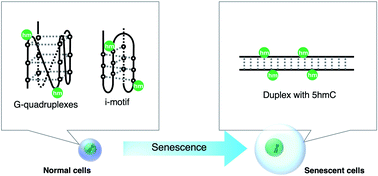Effect of DNA modifications on the transition between canonical and non-canonical DNA structures in CpG islands during senescence†
Abstract
Patterns and levels of DNA modifications play important roles in senescence. Two major epigenetic modifications of DNA, 5-methylcytosine (5mC) and 5-hydroxymethylcytosine (5hmC), target CpG sites. Importantly, CpG concentrated regions, known as CpG islands, contain GC-rich sequences, which have the potential to fold into non-canonical DNA structures such as i-motifs and G-quadruplexes. In this study, we investigated the effect of 5mC and 5hmC modifications on the transition between a duplex, and i-motif and G-quadruplexes. To examine the transition, we firstly investigated the stability and structure of the i-motif and G-quadruplexes, considering the molecular environment in senescent cells. Analyses of their stability showed that the modifications did not drastically affect the stability. However, noteworthily, the modification can weaken the (de)stabilisation effect on G-quadruplexes caused by cosolute(s) and cations. Circular dichroism analyses indicated that the surrounding environments, including the molecular crowding and the type of cations such as K+ and Na+, regulate the topology of G-quadruplexes, while neither 5mC nor 5hmC had a drastic effect. On the other hand, the modifications changed the transition between duplexes and quadruplexes. Unmodified DNA preferred to fold into quadruplexes, whereas DNA with 5mC and 5hmC preferred to fold into duplexes in the absence of PEG200; on the other hand, DNA with or without modifications tended to fold into i-motifs under crowded conditions. Furthermore, an investigation of quadruplexes forming sequences in CpG islands, which are hyper- or hypomethylated during senescence, followed by gene ontology enrichment analysis for each gene group classified by the presence of quadruplexes, showed a difference in function between genes with and without quadruplexes in the CpG region. These results indicate that it is important to consider the effects of patterns and levels of DNA modifications on the transition between canonical and non-canonical DNA structures to understand gene regulation by epigenetic modification during senescence.



 Please wait while we load your content...
Please wait while we load your content...